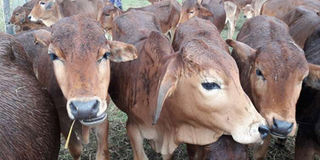Why you should consider rearing local dairy breeds

Embracing Sahiwals and other indigenous animals or their crossbreeds should be a matter of urgency for farmers, especially due to the increasingly unpredictable weather patterns. FILE PHOTO | NATION MEDIA GROUP
What you need to know:
- With the unpredictable and sometimes harsh climate conditions, it is becoming expensive to keep the hybrids.
- Animals such as Sahiwals have higher quality products.
- Stakeholders also noted there is need to put tough measures against bio-piracy.
The Kenya Agricultural and Livestock Research Organisation (Kalro), Naivasha, is an enchanting place. We toured the livestock section recently, with our interest being on the Sahiwal animals kept there.
The well-fattened animals, the kind that leaves one yearning for some roasted ribs, grazed leisurely at one section of the farm.
Dr Barasa Muhuyi, Kalro’s principal research scientist in-charge of animal breeding and genetics, said the current generation is Kenya’s own, after years of breeding.
“We have a total of 1,600 Sahiwal animals, some of which are being milked while bulls produce semen for breeding,” said Muhuyi, addressing a group of experts in the livestock sector, who had gathered on the farm as part of the Pan African Farmers Organisation (Pafo), forum which brought together representatives from 54 African countries.
Pafo is held once every two years and it focuses on protection, preservation and promotion of African indigenous livestock breeds.
The experts reckoned that embracing the Sahiwals and other indigenous animals or their crossbreeds should be an urgency for farmers, especially due to the increasingly unpredictable weather patterns.
Well, the entire world has gone crazy about the modern hybrids having abandoned the indigenous breeds in search of higher production, so why should farmers ‘regress’?
EMBRACE HARDY CATTLE BREEDS
“With the unpredictable and sometimes harsh climate conditions, it is becoming expensive to keep the hybrids because they need high maintenance, but our local animals are more resistant to things like diseases, low pasture and less water availability,” said Stephen Muchiri, CEO of East African Farmers Federation.
However, while they produce lesser, Muchiri noted animals such as Sahiwals have higher quality products.
“A hybrid dairy cow like Ayrshire and Friesian, for example, may produce 25 litres of milk daily while a cross-breed of Sahiwal about 20 litres but keeping the latter makes economic sense as it costs lower to feed and maintain it,” argued Muchiri.
He added that Africa needs to come up with policies that promote indigenous’ animal products.
“This can be through purchasing of milk in terms of quality and not necessarily quantity.”
Even as they pushed for African farmers to embrace the hardy breeds, stakeholders noted there is need to put tough measures against bio-piracy.
“Many foreigners visit Africa, take semen and animal genetics to cross-breed and manufacture vaccines yet the continent does not benefit much,” said Muchiri. Among indigenous breeds termed as at risk of extinction include Kenya’s Red Maasai sheep and South Africa’s Zulu sheep.





